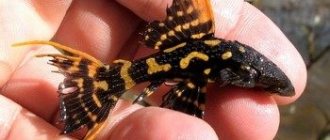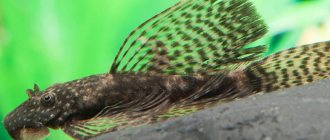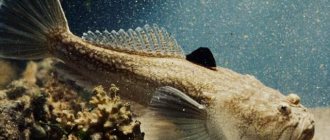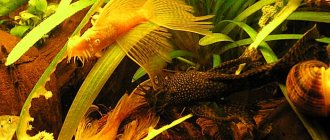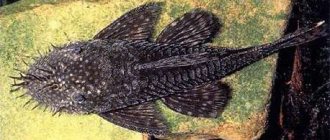An ordinary photo can be enlarged
Ancistrus are the most popular catfish in the aquarium world! Everyone knows them and maintains them, both beginners and pros. Ancistrus have earned such attention due to their qualities: they are classified as “aquarium orderlies”, they are unpretentious in maintenance, extraordinary in behavior and, of course, the structure of their sucker mouth noticeably distinguishes them from many other catfish-like fish.
At the same time, these fish can hardly be called handsome! A strange mouth, some warty growths on the face, dark coloring, and, as a rule, they often hide in snags and grottoes, they love twilight!
Ancistrus lives in the mountain rivers of South America in the tributaries of the Amazon, in the Andes in Peru, as well as in the upper reaches of the Orinoco in Venezuela. It was brought to the USSR in the late 70s.
The body shape of Ancistrus vulgaris is teardrop-shaped and flattened, the head is wide. The body is covered with rows of wide bony plates. The main color ranges from light gray yellowish to dark gray and black with light specks. The color is very variable and often ancistrus “turn pale”. Adult males can reach up to 10 cm. The mouth of the fish is in the form of a suction cup with elongated lips, equipped with horn-like scrapers that allow you to remove fouling from the walls of the aquarium, snags, and plant leaves. The male differs from the female in the presence of bushy, leathery processes on the head, which in females are either located only at the edges of the head and are poorly developed or absent. In addition, males are slimmer than females.
Description
Ancistrus vulgaris is a flattened fish covered with bony plates with a flag-shaped dorsal fin and a powerful tail. The fins on the chest and abdomen are well developed: this allows them to move through the water column. A strong tail helps to move against the current. Ancistrus do not have a swim bladder, so the fish spend most of their lives at the bottom.
The body of catfish is dark brown (sometimes grayish) with a scattering of light dots. This color resembles a starry sky. On the fins, the dots merge, turning into “strokes”. The fins themselves are bluish and dark tones. Black spots are visible on the caudal and dorsal fins, and olive spots on the ventral and pectoral fins.
The “folk” name for ancistrus is sucker catfish. It is associated with an unusual oral apparatus. There are well-developed suckers on the lips of this fish. The fish cling to rocks and snags to resist the flow of water. These suckers are “equipped” with a horny grater: it removes vegetation from smooth and rough surfaces. With the help of this “tool,” ancistrus not only get food for themselves, but also clean the aquarium. That’s why they are called “cleaners” and “orderlies.”
Features of Ancistrus catfish
This catfish is a unique fish because it differs from others in its unusual appearance and way of life. It has a suction cup mouth that sticks to aquarium walls, rocks, decorations and even plants. This mouth has horn-shaped scrapers that help clean objects around it, which is why it is called a cleaner.
Ancistrus does not swim, but moves in peculiar leaps. This catfish, unlike other fish, does not even have a swim bladder.
Under proper conditions in an aquarium, a catfish will live for about 7 years.
There are also visual differences between males and females. The male has tentacles (antennae) on his head. The female individual either does not have them, or the mustache is small and located on the sides. Ancistrus can also change sex. If a female lives alone for a long time, she can turn into a male.
If a female Ancistrus is alone for a long time, it can turn into a male.
As for coloring, the catfish has nothing to boast about. It has a dark gloomy color and is covered all over with white dots. Although, of course, like other species of fish, there are albinos, which have a bright yellow color.
So if a catfish is exploring the bottom, then at these moments it becomes an inconspicuous fish, which is even difficult to see.
The length of the stick reaches 10 cm, but if there is warm water in the aquarium, it will not reach them.
Maintenance and care
Ancistrus are considered one of the most unpretentious aquarium fish. They feel good in artificial reservoirs and are undemanding to water parameters. However, this does not mean that they can be kept in “Spartan” conditions. To recreate a natural habitat, you will have to follow the rules.
Recommended aquarium size
There is an opinion that ancistrus can be kept in aquariums with a volume of 20 liters or more. This is wrong. Sucker fish are very active, so they need a spacious jar. The minimum volume for a pair of ancistrus is 80 liters of water.
Catfish living in small containers suffer from stunted growth and are more susceptible to infectious diseases. They become covered in stress. With proper maintenance, ancistrus grow up to 15 cm.
Water parameters
Chain catfish are constantly busy searching for food and produce a lot of waste. Therefore, clean water is important to them. The aquarium must be equipped with a powerful filtration system. Also, the water must be saturated with oxygen. This assumes the presence of an aerator.
Comfortable water parameters:
- Temperature 20-28°C
- Acidity - 6-7.5 pH;
- Hardness - up to 20°.
Every week you need to change 1/3 of the total volume of water and “walk” through the soil with a siphon.
Aquarium decoration
Ancistrus are bottom-dwelling fish that are active in the dark. To feel safe, they need several types of shelters: grottoes, driftwood, coconut halves, pipes and inverted vessels. Males, most often, choose one shelter and guard it vigilantly. Keeping several pairs of ancistrus is fraught with constant fights. These are territorial fish that will defend their home from invasion. To avoid collisions, it is recommended to keep a male and several females.
The back wall of the aquarium needs to be planted with greenery. Plants serve not only as shelter, but also as the main source of food. Ancistrus will gnaw leaves and clean small algae from walls and decor.
The primer should have rolled edges and a dark color. Large stones should lie tightly on the bottom to prevent fish from crawling into the crack. There are known cases of catfish dying under stones. It is better to protect the filter outlet pipe with a mesh: ancistrus love the flow and can get inside. All decorative elements must be safe for fish. Sharp edges can cause serious wounds.
Lighting
Ancistrus prefer dim lighting, but plants need bright light to grow. Therefore, you need to alternate “dark” and “light” phases. Between them they take a half-hour break for twilight lighting. At this time the fish will be very active. Constant bright lighting can cause serious stress.
Diseases of catfish
When buying fish, many people do not even suspect that their pets can get sick. Identifying the disease in catfish can be problematic, because the fish are nocturnal and rarely swim out for public viewing in daylight. Ancistrus may experience a number of health problems:
- White spots on the fish's body may appear due to stress. In this case, we are not talking about illness, but about stress staining. In a stressful situation, ancistrus become dull and partially lose pigmentation. This can happen when transplanting a catfish from a familiar container to another aquarium, as well as after transportation. The infectious disease in the form of white spots can be carried by other fish. Therefore, after acquiring new neighbors for the catfish, they must be kept in a quarantine tank for at least 2 weeks. If the color of the catfish has changed and spots have appeared, it is also isolated. Quarantine and treatment last for at least 14 days. For treatment, purchase the drug Antipar.
- Ichthyophthiriasis resembles a scattering of semolina on the body of a fish. The disease is caused by the ciliate ichthyophthirius. For treatment, potassium permanganate, copper sulfate, malachite greens and formaldehyde are used. These substances can lead to the death of algae and invertebrates inhabiting the aquarium.
- Velvet disease or oodiniosis may not manifest itself for a long time, but under unfavorable conditions (stress, changes in water parameters) it will begin to progress. Sick individuals are characterized by reduced activity. Their fins turn into fragments of sharp rays, on which there is no interray tissue. The fish's skin will begin to peel off, and the body will resemble velvet fabric. Without treatment with antibiotics, the disease cannot be controlled. For 100 liters of water you will need 1 bottle of Bicillin-5. On the second day, perform a partial water change (30%) and repeat the administration of the drug. After 48 hours, the treatment is repeated, a control administration of the drug is carried out a week later. The treatment is considered effective, but the algae die.
- With chilodonellosis, cloudy areas of a bluish tint appear on the sides and back of the fish. It is necessary to examine the caudal fin if it is tightly compressed but not disheveled - this is a sure sign of disease. Levomycetin is used for treatment. For 100 liters of water, 3 g of the drug is needed. The product is added 3 times, maintaining 48-hour intervals. Before adding the dissolved drug, the water in the aquarium is replaced by 1/3. Additionally, you can raise the temperature in the aquarium to +28-30°C and add 3 tbsp to the water. salt. But such an additive will contribute to the death of algae.
- Dropsy is hard to miss. The catfish's belly swells and it stops defecating. For treatment, it is necessary to remove the sick individual and add Levomycetin (75 ml/l) or Ciprofloxacin (50 ml/l) to the water. The water temperature must be at least +27°C. Treatment is carried out for several days in a row. Effectiveness is indicated by a shrinking belly and the appearance of bowel movements.
From the editor: Asphyxia of fish
Ancistrus starata is a good choice for a freshwater aquarium. The peaceful existence of the catfish with other fish will allow it to rationally fill all layers of the home pond.
Feeding
Despite the fact that ancistrus are herbivorous fish, they need a varied diet. Tablets for bottom fish are suitable as the main diet. You also need to include greens and vegetables in the menu: zucchini, cucumbers, lettuce, carrots, spinach, peas and cabbage. Before giving vegetables to fish, they must be blanched or scalded with boiling water. Some ancistrus are afraid to eat near the surface, so vegetables can be attached with a rubber band to a stone or driftwood. From time to time, ancistrus need to be fed with live food: tubifex and bloodworms.
Ancistrus get most of their food by scraping the walls of the aquarium, driftwood and stones. Therefore, they should not be overfed. For an adult catfish, one tablet of food per day and a small amount of vegetables will be enough. Greens and vegetables should not remain in the aquarium for more than 12 hours.
Reproduction and breeding
Ancistrus are perfect for breeding at home. It is very easy to distinguish a male from a female: males have skin formations on their faces that resemble mustaches; they are slimmer and more graceful than females. In females, the mustache is completely absent or has the appearance of barely noticeable growths. Females participating in breeding must be larger than males; otherwise, they will be killed.
For successful spawning you need a spacious aquarium. Minimum volume - 40 l. A couple of breeders are placed in a spawning tank and the temperature is gradually increased by 2 degrees. Then the proportion of live and protein feeds is increased. Frequent water changes are very important. The spawning tank must be equipped with a filter and aerator. To avoid the female devouring eggs, you need to prepare a hatchery.
Females lay eggs in a safe place. The ideal option is a plastic pipe. After the female lays eggs, she is placed in a separate aquarium. If you miss the time, the “father” will kill the “mother” or she will eat the eggs. Only the “father” takes care of the offspring: he fans the eggs with his fins, providing an influx of fresh air. The “babies” hatch in 4-7 days.
After the “larvae” hatch, the male is also removed. At first, they feed on the yolk sac and are in a “resting state.” Grown-up fry switch to plant nutrition. They need to be fed spirulina, catfish tablets and finely chopped/mashed cucumber. Before serving, food and vegetables are crushed into fine crumbs so that the fry can swallow it.
Compatibility
Under normal conditions, Ancistrus does not show aggression and can coexist with all peaceful fish. The ideal option is viviparous and bottom-dwelling fish. It is strictly forbidden to keep ancistrus together with cichlids: the latter build “nests” at the bottom and will perceive the catfish as a dangerous predator. Also, you should not keep “suckers”, slow and scaleless fish in a common aquarium: the mouthparts of ancistrus can be a terrible weapon.
Diseases
One of the most common diseases of ancistrus is white spots. They are often confused with stress colors. It manifests itself in fading of the cover and can be associated with increased competition, small aquarium volume and a long light phase. White spots can also be a symptom of an infectious disease. The reason may be “newcomers” who have not completed the two-week quarantine.
Ancistrus, like other aquarium fish, are susceptible to ichthyophthyriasis (in other words, semolina). It appears in white, voluminous formations that resemble semolina. This disease enters the aquarium from the outside, so each fish must be quarantined.
Oodinosis is an “insidious”, common disease. Infected fish may carry the disease for several years without showing characteristic symptoms. If the content leaves much to be desired, the catfish’s natural defenses are reduced, and oodinosis begins to act in full force. Then the fish’s fins “stick together,” the interray tissue splits, and the skin peels off in places. The cover acquires a “velvet” structure, and the body of the catfish becomes a breeding ground for parasites.
If the owner follows all precautions, ancistrus can live up to 8 years. Average life expectancy: 4-6 years.
Main types
There are different types of Ancistrus catfish, so we’ll tell you about the main ones:
- Blue catfish antsister (common). Before puberty, their scales are bluish in color, and in adults they become dark gray with white spots on the body.
- Veiled. This species is distinguished by the presence of fairly large fins that flutter beautifully in the water. Color – dark olive with white spots on the body. The average size of an individual is 10 cm.
- Star-shaped. It is distinguished by a rich dark color, against which the white spots are especially noticeable. It is unpretentious, so it can live in various waters.
- Red. This is a selective species, bred artificially. It has a rich red color, so it is clearly visible in the aquarium. It is characterized by fairly high activity, which is not typical for other types of catfish.
- Albino (golden). These fish have no scale pigmentation, so they have a beige-golden color. In its habits it is not much different from other representatives of the chain mail family.
Ancistrus are unpretentious, but failure to follow dietary recommendations can lead to problems with the gastrointestinal tract, as well as helminth damage. Therefore, it is recommended to use only balanced food that contains all the necessary nutritional components.
